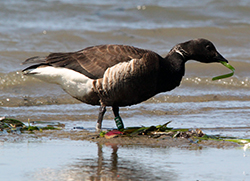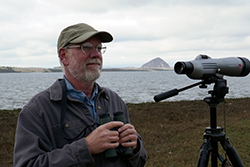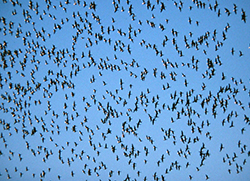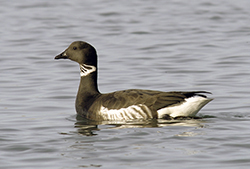
Banded black brant feeding on eelgrass

Volunteer John Roser in the field at Morro Bay

Flock of black brant in flight above Morro Bay

Black brant in Morro Bay
John Roser began hearing the stories shortly after he moved to Los Osos, San Luis Obispo County, on the shores of Morro Bay in the mid-1990s.
Longtime birders, waterfowl hunters, biologists and other coastal residents were all saying the same thing: It seemed fewer black brant were showing up on the bay each winter.
The coastal sea goose is a cultural icon of the area, the signature species of the Morro Bay Winter Bird Festival and a temporary visitor welcomed by locals as the geese arrive each fall from their summer breeding grounds in the Arctic. When the geese are present in big numbers, you can hear their cacophony almost anywhere on the bay from November through April or until the warm environs of Baja California lure the birds farther south on their migration.
Roser, who holds a degree in biology from Cal Poly San Luis Obispo and spent 25 years as an environmental educator, set out to see if the old-timers’ stories were true. For the past 21 years, he has provided CDFW and brant biologists throughout the Pacific Flyway with their most credible and reliable source of data on wintering brant in Morro Bay.<
“I’m retired, and I wanted to take on a volunteer project that would make a difference in this community,” Roser said of his motivation. “I wanted to create a Morro Bay specific data set significant enough that it would be valuable in brant studies and research across the Pacific Flyway.”
Roser’s initial efforts in 1997 focused on reading and reporting bands on individual birds with the help of a high-powered telescope. He has recorded more than 4,000 bands, including one affixed by a Russian ornithologist to a bird in Siberia some 5,000 miles away from Morro Bay where Roser spotted it. In addition to counting individual birds, Roser developed a formula – in consultation with brant biologists – to calculate the number of “brant use days” in Morro Bay each winter.
Roser’s retirement project has led him on a brant-like odyssey.
He banded brant one summer in Alaska, worked in Humboldt Bay with leading brant researcher Jeff Black and his Humboldt State University graduate students, and traveled to Baja California to help biologists read bands on birds at the extreme end of their southern range. Much of Roser’s winter observations take place at CDFW’s Morro Bay Wildlife Area.
“John is our go-to guy on the ground in Morro Bay for sure,” said Melanie Weaver, the head of CDFW’s Waterfowl Program. “We only have two employees in our program, myself included, so we depend on regional staff and volunteers like John to help compile survey data. John is part of the local community, he cares, and he is close to the resource.”
The data Roser supplies are incorporated into CDFW’s Mid-winter Waterfowl Survey, which is used to set hunting regulations for the following waterfowl season.
What attracts brant to Morro Bay is the same thing that prompts the birds to stop at other coastal bays along their southward migration: eelgrass. The underwater seagrass grows in shallow marine environments and is the birds’ primary food source.
Roser’s initial research in 1997 confirmed the reports he was hearing: The wintering brant population in Morro Bay had declined significantly and corresponded with a crash in eelgrass acreage in the bay.
While CDFW surveys from the 1930s through 1960s documented Morro Bay’s wintering brant population as high as 11,800 birds, Roser’s first survey in 1997 recorded a population high of fewer than 700 birds.
The eelgrass crash in the mid-1990s was temporary and well-understood, caused by an influx of sediment from a fire-ravaged landscape, a deluge of freshwater from a rainy year and warming El Nino ocean conditions. As environmental conditions normalized in subsequent years, the eelgrass rebounded, and the brant returned. Roser counted a population high of 4,600 birds in Morro Bay in 2001.
The story since then, as told in Roser’s annual reports to CDFW, is of another dramatic crash in eelgrass acreage in Morro Bay and a corresponding drop in the numbers of brant wintering there. Unlike the eelgrass crash of the mid-1990s, the latest decline has been more persistent and perplexing.
Biologists measure Morro Bay’s eelgrass acreage each year. Eelgrass spanned 344 acres as recently as 2007 but had dwindled to just 14 acres by 2017. Not surprisingly, Roser’s 2016-17 brant survey recorded a population high of just 319 birds and a low of 43. Roser’s brant-use-day metric has fallen by 90 percent since the nearly 500,000 brant use days he recorded in 2001. In the past five years, brant use days have measured around 50,000 a year. Money from the purchase of the California duck stamp-validation, required to hunt waterfowl in California, is funding research into the eelgrass decline along with restoration efforts.
In addition to fewer numbers of brant frequenting Morro Bay, Roser has noticed behavioral changes in the birds that still show up. Increasingly, the brant are foraging on secondary food sources that include salt marsh vegetation and green algae species such as sea lettuce with eelgrass in short supply.
Roser takes some solace that the overall Pacific Flyway brant population is holding steady if not increasing, estimated between 130,000 to 165,000 birds. Roser says waterfowl biologists are seeing flyway-wide changes in brant behavior that they suspect may be linked to climate change.
Fewer brant are migrating to Mexico for the winter. More are remaining in Alaska and their northern range throughout the year as warming Arctic conditions require fewer calorie demands and less ice exposes more eelgrass. Ten years ago, less than 10 percent of the population wintered in Alaska. By 2017, almost 40 percent of the Pacific Flyway population spent the winter there.
“This bird is tied to Morro Bay, our culture and our identity,” Roser said. “A robust wintering brant population needs abundant eelgrass beds. Eelgrass needs a healthy bay and watershed. Our actions as stewards of Morro Bay really do reverberate across the globe.”
CDFW photos: courtesy of John Roser
Top photo: Pair of black brant on Morro Bay